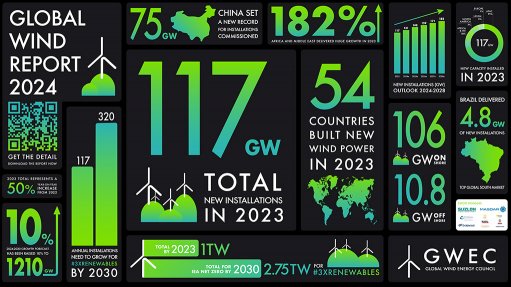Plastics manufacturer publishes guide on pipe pressure testing
Identifying a need to clarify the South African National Standards (SANS) organisation’s SANS 2001 pressure test regulations, plastic pipes manufacturer DPI Plastics last year developed and published a guide on how to conduct the pressure testing of pipes.
SANS 2001 is a comprehensive set of guidelines that covers installation practices, trenching, sewer pipelines and pipeline design.
DPI product manager Renier Snyman first presented the document at the South African Plastic Pipe Managers Association (Sappma) conference in September 2014.
He tells Engineering News that, when SANS 2001 was drafted, the organisation attempted to word the document precisely. However, this negatively affected readability for the average reader, which subsequently necessitated clarification of the document.
Snyman contacted South African Bureau of Standards (SABS) technical committee chairperson of construction Dr Ron Watermeyer, who initially devised and is still responsible for maintaining the standards, to clarify and confirm the meaning of a few of the regulations.
He adds that several engineers approached him after his presentation at the Sappma conference, expressing their surprise at the clarified standards, which they had previously misinterpreted.
Snyman maintains that, if companies adhere to SANS 2001, they will ensure the longevity of their pipes. He tells Engineering News that, while the current national standards were officially released in 2001, the method to test the pressure of pipes has barely changed since the 1970s.
Clarified Standards
Snyman explains that the required level of test pressure is often misinterpreted as 1.5 times the pressure rating on the pipe itself. However, it is, in fact, 1.5 times the working pressure of the pipeline.
He adds that, if the working pressure of a pipe is more than 10 bar, then the test pressure should be conducted at the working pressure plus 5 bar, and not by multiplying the working pressure by 1.5.
In addition, the calibration and position of the pressure gauge are often not considered. If a pipeline operates at an incline, and the pressure gauge is at the top, it can give false readings – with a difference of several bar – of the pressure that the pipeline is subjected to at the bottom, owing to the static head caused by the downward weight of the water.
Snyman states that a faulty pressure gauge can provide misleading information. “When one conducts a pressure reading incorrectly using faulty equipment or fails to take into account the position of the pressure gauge, overstressing of the pipeline can take place, reducing its life span.”
In addition, if the pipeline is immediately installed without conducting a pressure test, it becomes very difficult to identify leaks, particularly with long pipelines that can reach more than 10 km, Snyman adds.
Incorrect installation of semiflexible (plastic) pipes also commonly leads to overstressed pipes, as these require strong support from the soil around it and cannot be installed haphazardly, he notes.
High-density polyethylene (HDPE) pipes, typically used in farming practices, are an exception to this method of testing because they swell under test pressure, which causes the pressure to drop. This could be misinterpreted as a leak.
“We will, therefore, decide at the SABS technical committee meeting whether we should revise the method or create a separate method for HDPE pipes,” concludes Snyman.
Comments
Press Office
Announcements
What's On
Subscribe to improve your user experience...
Option 1 (equivalent of R125 a month):
Receive a weekly copy of Creamer Media's Engineering News & Mining Weekly magazine
(print copy for those in South Africa and e-magazine for those outside of South Africa)
Receive daily email newsletters
Access to full search results
Access archive of magazine back copies
Access to Projects in Progress
Access to ONE Research Report of your choice in PDF format
Option 2 (equivalent of R375 a month):
All benefits from Option 1
PLUS
Access to Creamer Media's Research Channel Africa for ALL Research Reports, in PDF format, on various industrial and mining sectors
including Electricity; Water; Energy Transition; Hydrogen; Roads, Rail and Ports; Coal; Gold; Platinum; Battery Metals; etc.
Already a subscriber?
Forgotten your password?
Receive weekly copy of Creamer Media's Engineering News & Mining Weekly magazine (print copy for those in South Africa and e-magazine for those outside of South Africa)
➕
Recieve daily email newsletters
➕
Access to full search results
➕
Access archive of magazine back copies
➕
Access to Projects in Progress
➕
Access to ONE Research Report of your choice in PDF format
RESEARCH CHANNEL AFRICA
R4500 (equivalent of R375 a month)
SUBSCRIBEAll benefits from Option 1
➕
Access to Creamer Media's Research Channel Africa for ALL Research Reports on various industrial and mining sectors, in PDF format, including on:
Electricity
➕
Water
➕
Energy Transition
➕
Hydrogen
➕
Roads, Rail and Ports
➕
Coal
➕
Gold
➕
Platinum
➕
Battery Metals
➕
etc.
Receive all benefits from Option 1 or Option 2 delivered to numerous people at your company
➕
Multiple User names and Passwords for simultaneous log-ins
➕
Intranet integration access to all in your organisation


















